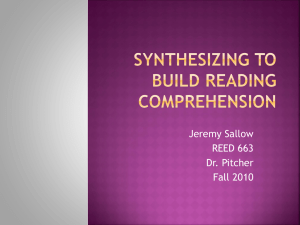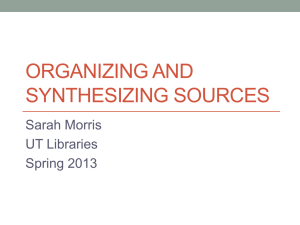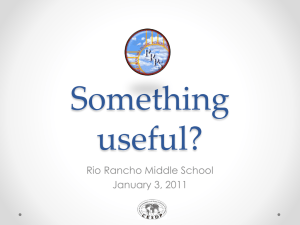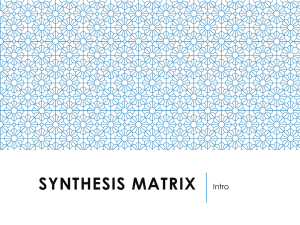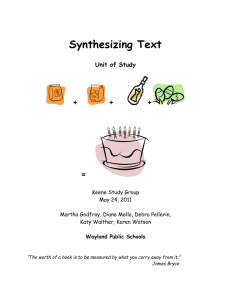Synthesizing Sources - Promoting Excellence in Graduate Studies
advertisement
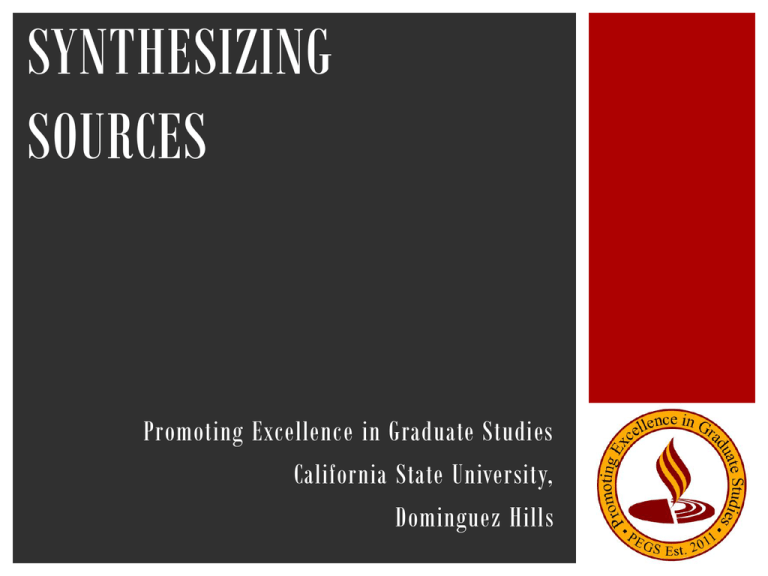
SYNTHESIZING SOURCES Promoting Excellence in Graduate Studies California State University, Dominguez Hills DISCLAIMER All workshops and workshop materials are the sole property of PEGS and cannot be published, copied, or disseminated without prior written approval from PEGS; they are for student and faculty use only. SYNTHESIZING SOURCES: WHAT DOES IT MEAN? In short, a synthesis simply combines elements from multiple sources to form a whole; in this case, the “whole” is a theme or argument within your paper. Synthesizing involves identifying patterns and dif ferences among sources; critically analyzing strengths, weaknesses, methods, and findings; and describing gaps in knowledge to determine what you, as a student, can contribute to future research on the topic. FIVE TASKS IN SYNTHESIZING According to Jamieson (1999) there are five tasks required for ef fectively synthesizing source material: 1. 2. 3. 4. 5. Frame the Subject Gather Material Organize Information Write the Synthesis Unify the Presentation FRAMING THE SUBJECT & GATHERING MATERIAL At this point, you should have already identified a potential research topic and gathered relevant and current research material. The next step, organizing your information , is crucial in writing ef fective syntheses because it allows you to easily identify how you can make connections between sources. Ultimately, these “connections” will evolve into the themes of your paper. “Connections” is used here in a general sense to indicate any type of relationship between sources: Similarities or agreement Opposing viewpoints Contradictory findings Varying opinions ORGANIZING INFORMATION You will need to read through each of your source texts at least twice. The first time through, you will begin to get an overall sense of where you can make connections. The second time through, you will need to make strategic annotations (take notes, highlight, underline, etc.). Try and indicate similar or connecting ideas by using a different method of annotation for each emerging theme. Let’s say that a cursory reading of research related to the topic of human behavior indicates that there are several factors (i.e., themes) that we have discovered to explain what motivates human behavior: self -concept, reward, internal forces, autonomy and self-control, and narcissism. ORGANIZING INFORMATION Lists can be very helpful when organizing your information List 1: Summary of info that is in all sources (probably means this is CENTRAL information) List 2: Summary of info that is in some sources (could be CENTRAL; could be PERIPHERAL) List 3: Information that is NOT shared among sources (probably PERIPHERAL -- meaning, specific to the source you are reading, but not necessarily to your research) THE SYNTHESIS MATRIX The synthesis matrix is by far one of the most useful tools that you can use to create an “at -a-glance” reference for synthesizing sources. WRITING THE SYNTHESIS In addition to identifying conflicts and points of agreement among sources, here are some more suggestions for writing a highly ef fective synthesis: Connect facts with interpretations For example, Karl Marx’s theory of history (interpretation) is connected to the observable social phenomenon of class struggle (fact). Discuss all relevant data, including evidence that is contrary to your thesis. Do not use quotes or data out of context: stay true to the original author’s intentions. THE INTRODUCTORY SYNTHESIS THE BACKGROUND SYNTHESIS SYNTHESIS PARAGRAPH INCLUDING ANALYSIS REFERENCES American Psychological Association. (2010). Publication manual of the american psychological association . (6th ed.). Washington, D.C.: American Psychological Association. Henning, T. B. (2011). Literature review: Synthesizing multiple sources . Retrieved from http://www.google.com/url?sa=t&rct=j&q=&esrc=s&frm=1&source=web&cd=1&ved=0CC0QFjAA&url=http: //www.english.lsu.edu/English_UWriting/FILES/item35404.pdf&ei=ePb6UaWNEKGciQLUloGwDQ&usg=AFQj CNGb6Yq2JVSEIVHidpMjvtvstDS5FA&sig2=Z8U -ThAQL1_0kM0R0e7ocw Jamieson, S. (1999). Synthesis writing. Retrieved from http://www.users.drew.edu/sjamieso/synthesis.html Mauk, K. (2008). Synthesizing sources. Retrieved from Mauk, K. (2008, May 7). Synthesizing sources. Retrieved from http://www.cengage.com/custom/enrichment_modules/data/142826213X_WH_Synthesizing_watermark.p df Temple University Writing Center. (n.d.). Synthesizing sources. Retrieved from http://www.temple.edu/writingctr/support -for-writers/documents/SynthesizingSources.pdf University of Florida. (n.d.). Synthesizing sources. Retrieved from http://web.clas.ufl.edu/users/msscha/synthesizing_sources.pdf Walden University Online Writing Center. (2012). Final paper: Weekly breakdown of assignments . Retrieved from http://libraryguides.waldenu.edu/content.php?pid=408802&sid=3344538
